Hostile And Closed Environments, Hazards At Close Quarters
Hostile and Closed Environments, Hazards at Close Quarters
A human journey to Mars, at first glance, offers an inexhaustible amount of complexities. To bring a mission to the Red Planet from fiction to fact, NASA’s Human Research Program has organized some of the hazards astronauts will encounter on a continual basis into five classifications.

A spacecraft is not only a home, it’s also a machine. NASA understands that the ecosystem inside a vehicle plays a big role in everyday astronaut life.

Important habitability factors include temperature, pressure, lighting, noise, and quantity of space. It’s essential that astronauts are getting the requisite food, sleep and exercise needed to stay healthy and happy. The space environment introduces challenges not faced on Earth.

Technology, as often is the case with out-of-this-world exploration, comes to the rescue! Technology plays a big role in creating a habitable home in a harsh environment and monitoring some of the environmental conditions.

Astronauts are also asked to provide feedback about their living environment, including physical impressions and sensations so that the evolution of spacecraft can continue addressing the needs of humans in space.


Exploration to the Moon and Mars will expose astronauts to five known hazards of spaceflight, including hostile and closed environments, like the closed environment of the vehicle itself. To learn more, and find out what NASA’s Human Research Program is doing to protect humans in space, check out the “Hazards of Human Spaceflight“ website. Or, check out this week’s episode of “Houston We Have a Podcast,” in which host Gary Jordan further dives into the threat of hostile and closed environments with Brian Crucian, NASA immunologist at the Johnson Space Center.

Make sure to follow us on Tumblr for your regular dose of space: http://nasa.tumblr.com.
More Posts from Ocrim1967 and Others



Happy Birthday, Albert Einstein! Genius Scientist Turns 140 Years Old Today.
The year 1905 came to be known as Einstein’s Miracle Year. He was 26 years old, and in that year he published four papers that reshaped physics.
Photoelectric effect
The first explained what’s called the photoelectric effect – one of the bases for modern-day electronics – with practical applications including television. His paper on the photoelectric effect helped pave the way for quantum mechanics by establishing that light is both a particle and a wave. For this work, Einstein was later awarded a Nobel Prize in physics.


Brownian motion
Another 1905 paper related to Brownian motion. In it, Einstein stated that the seemingly random motion of particles in a fluid (Brownian motion) was a predictable, measurable part of the movement of atoms and molecules. This helped establish the Kinetic Molecular Theory of Heat, which says that, if you heat something, its molecules begin to vibrate. At this same time, Einstein provided definitive confirmation that atoms and molecules actually exist.


Special relativity
Also in 1905, Einstein published his Special Theory of Relativity. Before it, space, time and mass all seemed to be absolutes – the same for everyone. Einstein showed that different people perceive mass, space and time differently, but that these effects don’t show up until you start moving nearly at the speed of light. Then you find, for example, that time on a swiftly moving spaceship slows down, while the mass of the ship increases. According to Einstein, a spaceship traveling at the speed of light would have infinite mass, and a body of infinite mass also has infinite resistance to motion. And that’s why nothing can accelerate to a speed faster than light speed. Because of Einstein’s special relativity, light is now seen as an absolute in a universe of shifting values for space, time and matter.

Mass-energy equivalence
The fourth 1905 paper stated that mass and energy are equivalent. You perhaps know something of this work in Einstein’s famous equation E=mc2. That equation means that energy (E) is equal to mass (m) multiplied by the speed of light © squared. Sound simple? It is, in a way. It means that matter and energy are the same thing. It’s also very profound, in part because the speed of light is a huge number. As shown by the equation, a small amount of mass can be converted into a large amount of energy … as in atomic bombs. It’s this same conversion of mass to energy, by the way, that causes stars to shine.
But Einstein didn’t stop there. As early as 1911, he’d predicted that light passing near a large mass, such as a star, would be bent. That idea led to his General Theory of Relativity in 1916.


This paper established the modern theory of gravitation and gave us the notion of curved space. Einstein showed, for example, that small masses such as planets form dimples in space-time that hardly affect the path of starlight. But big masses such as stars produce measurably curved space.





The fact that the curved space around our sun was measurable let other scientists prove Einstein’s theory. In 1919, two expeditions organized by Arthur Eddington photographed stars near the sun made visible during a solar eclipse. The displacement of these stars with respect to their true positions on the celestial sphere showed that the sun’s gravity does cause space to curve so that starlight traveling near the sun is bent from its original path. This observation confirmed Einstein’s theory, and made Einstein a household name.
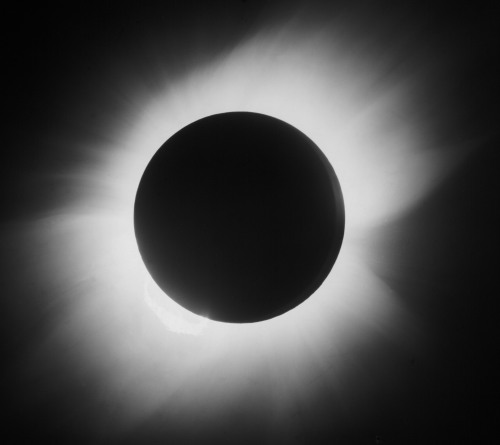
Source (read more) posts about Einstein




Couple goals










This Is What The Milky Way’s Magnetic Field Looks Like
“The Milky Way’s gas, dust, stars and more create fascinating, measurable structures. Subtracting out all the foregrounds yields the cosmic background signal, which possesses tiny temperature imperfections. But the galactic foreground isn’t useless; it’s a map unto itself. All background light gets polarized by these foregrounds, enabling the reconstruction of our galaxy’s magnetic field.”
Have you ever wondered what our galaxy’s magnetic field looks like? As long as we restrict ourselves to looking in the type of light that human eyes can see, the optical portion of the spectrum, we’re extremely limited as far as what we can infer. However, if we move on to data from the microwave portion of the spectrum, and in particular we look at the data that comes from the polarization of background light (and the foreground light directly), we should be able to reconstruct our galaxy’s magnetic fields to the best precision ever. The Planck satellite, in addition to mapping the CMB to better precision than ever before, has enabled us to do exactly that.
Even though there are still some small questions and uncertainties, you won’t want to miss these incredible pictures that showcase just how far we’ve come!
Make Sure You Observe the Moon on October 20
On Saturday, October 20, NASA will host the ninth annual International Observe the Moon Night. One day each year, everyone on Earth is invited to observe and learn about the Moon together, and to celebrate the cultural and personal connections we all have with our nearest celestial neighbor.
There are a number of ways to celebrate. You can attend an event, host your own, or just look up! Here are 10 of our favorite ways to observe the Moon:
1. Look up

Image credit: NASA’s Scientific Visualization Studio/Ernie Wright
The simplest way to observe the Moon is simply to look up. The Moon is the brightest object in our night sky, the second brightest in our daytime sky and can be seen from all around the world — from the remote and dark Atacama Desert in Chile to the brightly lit streets of Tokyo. On October 20, the near side of the Moon, or the side facing Earth, will be about 80 percent illuminated, rising in the early evening.
See the Moon phase on October 20 or any other day of the year!
2. Peer through a telescope or binoculars

The Moon and Venus are great targets for binoculars. Image Credit: NASA/Bill Dunford
With some magnification help, you will be able to focus in on specific features on the Moon, like the Sea of Tranquility or the bright Copernicus Crater. Download our Moon maps for some guided observing on Saturday.
3. Photograph the Moon

Image credit: NASA/GSFC/ASU
Our Lunar Reconnaissance Orbiter (LRO) has taken more than 20 million images of the Moon, mapping it in stunning detail. You can see featured, captioned images on LRO’s camera website, like the one of Montes Carpatus seen here. And, of course, you can take your own photos from Earth. Check out our tips on photographing the Moon!
4. Take a virtual field trip

Image credit: NASA/JPL-Caltech
Plan a lunar hike with Moontrek. Moontrek is an interactive Moon map made using NASA data from our lunar spacecraft. Fly anywhere you’d like on the Moon, calculate the distance or the elevation of a mountain to plan your lunar hike, or layer attributes of the lunar surface and temperature. If you have a virtual reality headset, you can experience Moontrek in 3D.
5. Touch the topography

Image credit: NASA GSFC/Jacob Richardson
Observe the Moon through touch! If you have access to a 3D printer, you can peruse our library of 3D models and lunar landscapes. This model of the Apollo 11 landing site created by NASA scientist Jacob Richardson, is derived from LRO’s topographic data. Near the center, you can actually feel a tiny dot where astronauts Neil Armstrong and Buzz Aldrin left the Lunar Descent Module.
6. Make Moon art

Image credit: LPI/Andy Shaner
Enjoy artwork of the Moon and create your own! For messy fun, lunar crater paintings demonstrate how the lunar surface changes due to consistent meteorite impacts.
7. Relax on your couch

Image credit: NASA’s Scientific Visualization Studio/Ernie Wright
There are many movies that feature our nearest neighbor, from A Voyage to the Moon by George Melies, to Apollo 13, to the newly released First Man. You can also spend your evening with our lunar playlist on YouTube or this video gallery, learning about the Moon’s role in eclipses, looking at the Moon phases from the far side, and seeing the latest science portrayed in super high resolution. You’ll impress all of your friends with your knowledge of supermoons.
8. Listen to the Moon
Video credit: NASA’s Scientific Visualization Studio/Ernie Wright
Make a playlist of Moon songs. For inspiration, check out this list of lunar tunes. We also recommend LRO’s official music video, The Moon and More, featuring Javier Colon, season 1 winner of NBC’s “The Voice.” Or you can just watch this video featuring “Clair de Lune,” by French composer Claude Debussy, over and over.
9. See the Moon through the eyes of a spacecraft

Image credit: NASA/GSFC/MIT
Visible light is just one tool that we use to explore our universe. Our spacecraft contain many different types of instruments to analyze the Moon’s composition and environment. Review the Moon’s gravity field with data from the GRAIL spacecraft or decipher the maze of this slope map from the laser altimeter onboard LRO. This collection from LRO features images of the Moon’s temperature and topography. You can learn more about our different missions to explore the Moon here.
10. Continue your observations throughout the year

Image credit: NASA’s Scientific Visualization Studio/Ernie Wright
An important part of observing the Moon is to see how it changes over time. International Observe the Moon Night is the perfect time to start a Moon journal. See how the shape of the Moon changes over the course of a month, and keep track of where and what time it rises and sets. Observe the Moon all year long with these tools and techniques!
However you choose to celebrate International Observe the Moon Night, we want to hear about it! Register your participation and share your experiences on social media with #ObserveTheMoon or on our Facebook page. Happy observing!
Make sure to follow us on Tumblr for your regular dose of space: http://nasa.tumblr.com.
The Shrinking Aral Sea
The Aral Sea was once the fourth-largest lake in the world. Fed primarily by snowmelt and precipitation flowing down from faraway mountains, it was a temperate oasis in an arid region. But in the 1960s, the Soviet Union diverted two major rivers to irrigate farmland, cutting off the inland sea from its source. As the Aral Sea dried up, fisheries collapsed, as did the communities that depended on them. The remaining water supply became increasingly salty and polluted with runoff from agricultural plots. Loss of the Aral Sea’s water influenced regional climate, making the winters even colder and the summers much hotter.

While seasonal rains still bring water to the Aral Sea, the lake is roughly one-tenth of its original size. These satellite images show how the Aral Sea and its surrounding landscape has changed over the past few decades.
For more details about these images, read the full stories here: https://go.nasa.gov/2PqJ1ot
Make sure to follow us on Tumblr for your regular dose of space: http://nasa.tumblr.com
What is an Exoplanet?
An exoplanet or extrasolar planet is a planet outside our solar system that orbits a star. The first evidence of an exoplanet was noted as early as 1917, but was not recognized as such. However, the first scientific detection of an exoplanet was in 1988. Shortly afterwards, the first confirmed detection was in 1992. As of 1 April 2018, there are 3,758 confirmed planets in 2,808 systems, with 627 systems having more than one planet.

The High Accuracy Radial Velocity Planet Searcher (HARPS, since 2004) has discovered about a hundred exoplanets while the Kepler space telescope (since 2009) has found more than two thousand. Kepler has also detected a few thousand candidate planets, of which about 11% may be false positives.

In several cases, multiple planets have been observed around a star. About 1 in 5 Sun-like stars have an “Earth-sized” planet in the habitable zone. Assuming there are 200 billion stars in the Milky Way, one can hypothesize that there are 11 billion potentially habitable Earth-sized planets in the Milky Way, rising to 40 billion if planets orbiting the numerous red dwarfs are included.

The least massive planet known is Draugr (also known as PSR B1257+12 A or PSR B1257+12 b), which is about twice the mass of the Moon. The most massive planet listed on the NASA Exoplanet Archive is HR 2562 b, about 30 times the mass of Jupiter, although according to some definitions of a planet, it is too massive to be a planet and may be a brown dwarf instead.

There are planets that are so near to their star that they take only a few hours to orbit and there are others so far away that they take thousands of years to orbit.

Some are so far out that it is difficult to tell whether they are gravitationally bound to the star. Almost all of the planets detected so far are within the Milky Way. Nonetheless, evidence suggests that extragalactic planets, exoplanets further away in galaxies beyond the local Milky Way galaxy, may exist. The nearest exoplanet is Proxima Centauri b, located 4.2 light-years (1.3 parsecs) from Earth and orbiting Proxima Centauri, the closest star to the Sun.

Besides exoplanets, there are also rogue planets, which do not orbit any star and which tend to be considered separately, especially if they are gas giants, in which case they are often counted, like WISE 0855−0714, as sub-brown dwarfs. The rogue planets in the Milky Way possibly number in the billions (or more).

Some planets orbit one member of a binary star system, and several circumbinary planets have been discovered which orbit around both members of binary star. A few planets in triple star systems are known and one in the quadruple system Kepler-64.

Methods of detecting exoplanets
1° Radial velocity
A star with a planet will move in its own small orbit in response to the planet’s gravity. This leads to variations in the speed with which the star moves toward or away from Earth, i.e. the variations are in the radial velocity of the star with respect to Earth. The radial velocity can be deduced from the displacement in the parent star’s spectral lines due to the Doppler effect. The radial-velocity method measures these variations in order to confirm the presence of the planet using the binary mass function.

2º Transit photometry
While the radial velocity method provides information about a planet’s mass, the photometric method can determine the planet’s radius. If a planet crosses (transits) in front of its parent star’s disk, then the observed visual brightness of the star drops by a small amount; depending on the relative sizes of the star and the planet.

3° Direct Imaging
Exoplanets are far away, and they are millions of times dimmer than the stars they orbit. So, unsurprisingly, taking pictures of them the same way you’d take pictures of, say Jupiter or Venus, is exceedingly hard.
New techniques and rapidly-advancing technology are making it happen.
The major problem astronomers face in trying to directly image exoplanets is that the stars they orbit are millions of times brighter than their planets. Any light reflected off of the planet or heat radiation from the planet itself is drowned out by the massive amounts of radiation coming from its host star. It’s like trying to find a flea in a lightbulb, or a firefly flitting around a spotlight.

On a bright day, you might use a pair of sunglasses, or a car’s sun visor, or maybe just your hand to block the glare of the sun so that you can see other things.
This is the same principle behind the instruments designed to directly image exoplanets. They use various techniques to block out the light of stars that might have planets orbiting them. Once the glare of the star is reduced, they can get a better look at objects around the star that might be exoplanets.
4° Gravitational Microlensing
Gravitational microlensing occurs when the gravitational field of a star acts like a lens, magnifying the light of a distant background star. This effect occurs only when the two stars are almost exactly aligned. Lensing events are brief, lasting for weeks or days, as the two stars and Earth are all moving relative to each other. More than a thousand such events have been observed over the past ten years.

If the foreground lensing star has a planet, then that planet’s own gravitational field can make a detectable contribution to the lensing effect. Since that requires a highly improbable alignment, a very large number of distant stars must be continuously monitored in order to detect planetary microlensing contributions at a reasonable rate. This method is most fruitful for planets between Earth and the center of the galaxy, as the galactic center provides a large number of background stars.
5° Astrometry
This method consists of precisely measuring a star’s position in the sky, and observing how that position changes over time. Originally, this was done visually, with hand-written records. By the end of the 19th century, this method used photographic plates, greatly improving the accuracy of the measurements as well as creating a data archive. If a star has a planet, then the gravitational influence of the planet will cause the star itself to move in a tiny circular or elliptical orbit.

Effectively, star and planet each orbit around their mutual centre of mass (barycenter), as explained by solutions to the two-body problem. Since the star is much more massive, its orbit will be much smaller. Frequently, the mutual centre of mass will lie within the radius of the larger body. Consequently, it is easier to find planets around low-mass stars, especially brown dwarfs.
source
source (+ Methods of detecting exoplanets)
source
images: NASA/ESA, ESO
animations: x, x, x, x, x
+ Exoplanets
Some intriguing exoplanets

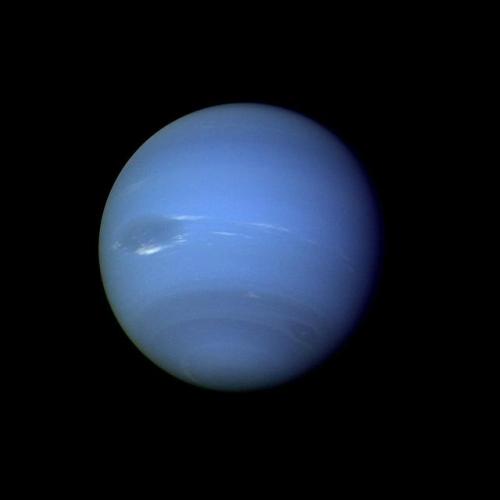
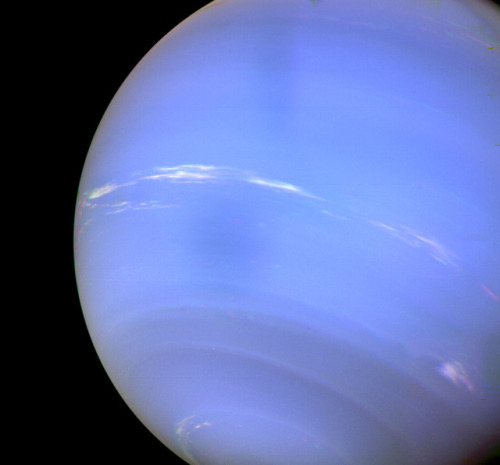
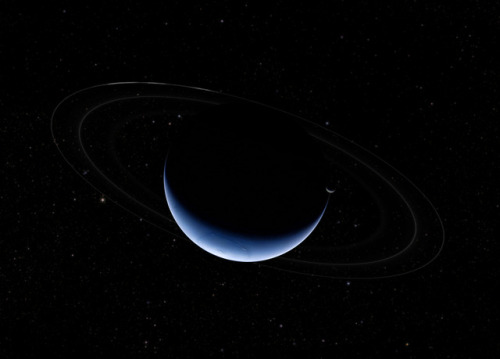
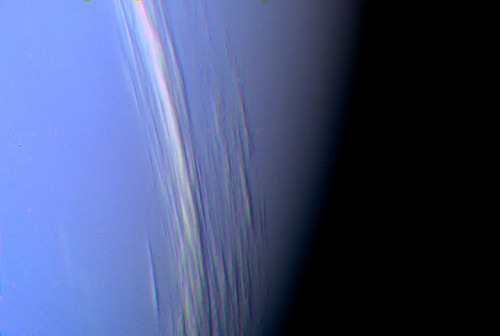
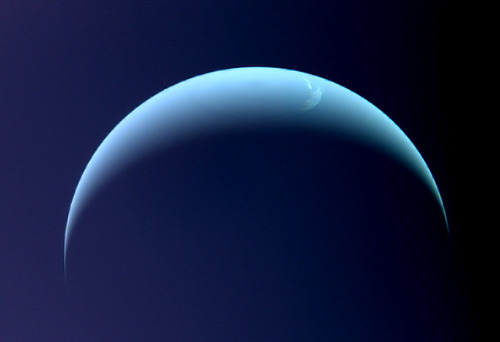
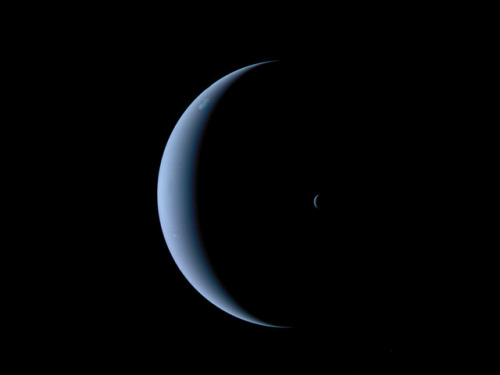
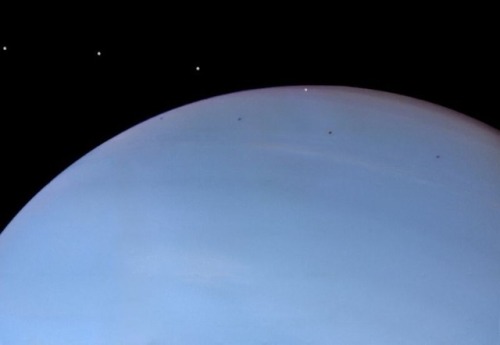
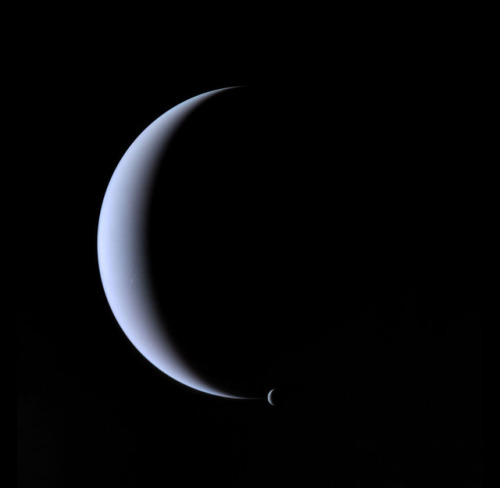
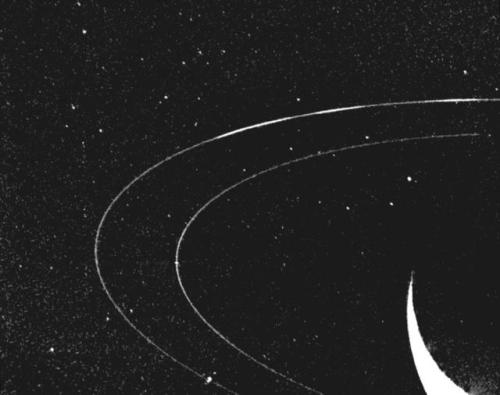
Neptune ♆
On this day in 1846 was discovered the planet Neptune.
The ice giant Neptune was the first planet located through mathematical predictions rather than through regular observations of the sky. (Galileo had recorded it as a fixed star during observations with his small telescope in 1612 and 1613.) When Uranus didn’t travel exactly as astronomers expected it to, a French mathematician, Urbain Joseph Le Verrier, proposed the position and mass of another as yet unknown planet that could cause the observed changes to Uranus’ orbit. After being ignored by French astronomers, Le Verrier sent his predictions to Johann Gottfried Galle at the Berlin Observatory, who found Neptune on his first night of searching in 1846. Seventeen days later, its largest moon, Triton, was also discovered.
Neptune is invisible to the naked eye because of its extreme distance from Earth. Interestingly, the highly eccentric orbit of the dwarf planet Pluto brings Pluto inside Neptune’s orbit for a 20-year period out of every 248 Earth years. Pluto can never crash into Neptune, though, because for every three laps Neptune takes around the Sun, Pluto makes two. This repeating pattern prevents close approaches of the two bodies.
Nearly 4.5 billion kilometers (2.8 billion miles) from the Sun, Neptune orbits the Sun once every 165 years.
Uranus’ blue-green color is also the result of atmospheric methane, but Neptune is a more vivid, brighter blue, so there must be an unknown component that causes the more intense color.
Despite its great distance and low energy input from the Sun, Neptune’s winds can be three times stronger than Jupiter’s and nine times stronger than Earth’s.
Winds on Neptune travel faster than the speed of sound.
In 1989, Voyager 2 tracked a large, oval-shaped, dark storm in Neptune’s southern hemisphere. This “Great Dark Spot” was large enough to contain the entire Earth.
Neptune has five known rings. Voyager 2’s observations confirmed that these unusual rings are not uniform but have four thick regions (clumps of dust) called arcs. The rings are thought to be relatively young and short-lived.
Neptune has 14 known moons, six of which were discovered by Voyager 2.
Triton, Neptune’s largest moon, orbits the planet in the opposite direction compared with the rest of the moons, suggesting that it may have been captured by Neptune in the distant past.
To know more about the planet Neptune click here and here.
Images credit: NASA/JPL- Caltech (some images processed by Kevin M. Gill)
All Cats Are Beautiful


























(Source)

We are swooningggg over this NEW Saturn image.
Saturn is so beautiful that astronomers cannot resist using the Hubble Space Telescope to take yearly snapshots of the ringed world when it is at its closest distance to Earth. 😍
These images, however, are more than just beauty shots. They reveal exquisite details of the planet as a part of the Outer Planets Atmospheres Legacy project to help scientists understand the atmospheric dynamics of our solar system’s gas giants.
This year’s Hubble offering, for example, shows that a large storm visible in the 2018 Hubble image in the north polar region has vanished. Also, the mysterious six-sided pattern – called the “hexagon” – still exists on the north pole. Caused by a high-speed jet stream, the hexagon was first discovered in 1981 by our Voyager 1 spacecraft.
Saturn’s signature rings are still as stunning as ever. The image reveals that the ring system is tilted toward Earth, giving viewers a magnificent look at the bright, icy structure.
Image Credit: NASA, ESA, A. Simon (GSFC), M.H. Wong (University of California, Berkeley) and the OPAL Team
Make sure to follow us on Tumblr for your regular dose of space: http://nasa.tumblr.com
-
 riyel-arcangel liked this · 4 years ago
riyel-arcangel liked this · 4 years ago -
 rainbowfoam liked this · 5 years ago
rainbowfoam liked this · 5 years ago -
 da2en-blog liked this · 6 years ago
da2en-blog liked this · 6 years ago -
 tumvioky liked this · 6 years ago
tumvioky liked this · 6 years ago -
 themissdreamingstories liked this · 6 years ago
themissdreamingstories liked this · 6 years ago -
 spacedragonsattack liked this · 6 years ago
spacedragonsattack liked this · 6 years ago -
 sweet-alien-dreams reblogged this · 6 years ago
sweet-alien-dreams reblogged this · 6 years ago -
 bigolechompers liked this · 6 years ago
bigolechompers liked this · 6 years ago -
 goddessofliteratureandsarcasm liked this · 6 years ago
goddessofliteratureandsarcasm liked this · 6 years ago -
 agalonofmilk liked this · 6 years ago
agalonofmilk liked this · 6 years ago -
 ceem902 liked this · 6 years ago
ceem902 liked this · 6 years ago -
 cyko-tik-tabaxi liked this · 6 years ago
cyko-tik-tabaxi liked this · 6 years ago -
 raninburyy reblogged this · 6 years ago
raninburyy reblogged this · 6 years ago -
 raninburyy liked this · 6 years ago
raninburyy liked this · 6 years ago -
 30spiders liked this · 6 years ago
30spiders liked this · 6 years ago -
 darknessncupcakes reblogged this · 6 years ago
darknessncupcakes reblogged this · 6 years ago -
 darknessncupcakes liked this · 6 years ago
darknessncupcakes liked this · 6 years ago -
 ghost809 liked this · 6 years ago
ghost809 liked this · 6 years ago -
 richardaspdenofficial liked this · 6 years ago
richardaspdenofficial liked this · 6 years ago -
 kamkong liked this · 6 years ago
kamkong liked this · 6 years ago -
 humanityissstrange reblogged this · 6 years ago
humanityissstrange reblogged this · 6 years ago -
 providencediscord liked this · 6 years ago
providencediscord liked this · 6 years ago -
 cara-linea reblogged this · 6 years ago
cara-linea reblogged this · 6 years ago -
 marillenschnapps liked this · 6 years ago
marillenschnapps liked this · 6 years ago -
 blackjackkent reblogged this · 6 years ago
blackjackkent reblogged this · 6 years ago -
 as-warm-as-choco liked this · 6 years ago
as-warm-as-choco liked this · 6 years ago -
 barsefrin-blog liked this · 6 years ago
barsefrin-blog liked this · 6 years ago -
 astra-peraspera reblogged this · 6 years ago
astra-peraspera reblogged this · 6 years ago -
 orangemailbox liked this · 6 years ago
orangemailbox liked this · 6 years ago -
 theamazingneve liked this · 6 years ago
theamazingneve liked this · 6 years ago -
 foxjevilwild liked this · 6 years ago
foxjevilwild liked this · 6 years ago -
 cohobbitation reblogged this · 6 years ago
cohobbitation reblogged this · 6 years ago -
 knittasticacelesbian liked this · 6 years ago
knittasticacelesbian liked this · 6 years ago -
 tinsnip reblogged this · 6 years ago
tinsnip reblogged this · 6 years ago -
 the-demon-colonel liked this · 6 years ago
the-demon-colonel liked this · 6 years ago -
 briardragon reblogged this · 6 years ago
briardragon reblogged this · 6 years ago -
 -reks- liked this · 6 years ago
-reks- liked this · 6 years ago -
 blessedburial reblogged this · 6 years ago
blessedburial reblogged this · 6 years ago -
 headbubbles liked this · 6 years ago
headbubbles liked this · 6 years ago -
 galladon reblogged this · 6 years ago
galladon reblogged this · 6 years ago -
 chekhov-memes reblogged this · 6 years ago
chekhov-memes reblogged this · 6 years ago -
 podcasts-8-my-heart liked this · 6 years ago
podcasts-8-my-heart liked this · 6 years ago